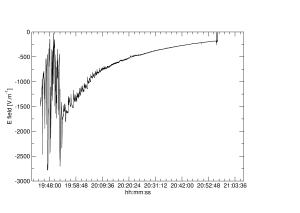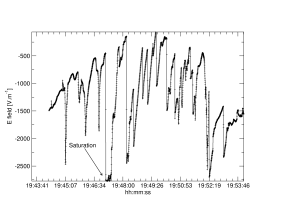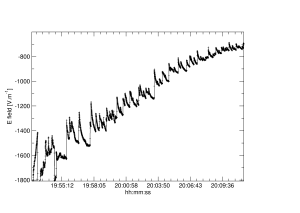Hi,
I am an electronic enthousiastic and of course a Blitzortung fan. In order to complete my lightning detection sensoric I developed a field mill to detect the change of the electrical field (not the electric part of the electromagnetic wave but the quasi steady electric field) when a thunderstorm is over my garden. It took times and several trial and errors but at least I managed it.
About the concept:
The device is working with USB (and can be used with a simple power bank) and generate a local wifi network so that one can monitor the results on the smartphone. Typically, you are on a hot spot far from home it is rainy and you stay in your car monitoring the change of electrical field.

If it is worthwhile I may invest time showing how I did it, it was a very nice first project and may be some other people may profit of it.
About the results:
There was a thunderstorm over Mainz (DE) during the evening of 21.04.2023.


and I could extract the following plot representing the charges and the discharges of the cloud above me. Very interesting was to observe a lightning and few milliseconds later on the Webserver of the field mill the drop down of the electrical field. It is really like a capacitor charing till reaching the electrical breakdown. Also very interesting is to observe how long it takes to converge back to a 0 V/m field even if no clouds were to be seen.
More on this picture here below:



All of this would not have been possible without the input from this website (Stefan Kneifel).
I hope that you find this as exciting as I found it. Do not hesitate to share your feelings and questions about it.
Regards
User: 1871
Detector: 2432
I am an electronic enthousiastic and of course a Blitzortung fan. In order to complete my lightning detection sensoric I developed a field mill to detect the change of the electrical field (not the electric part of the electromagnetic wave but the quasi steady electric field) when a thunderstorm is over my garden. It took times and several trial and errors but at least I managed it.
About the concept:
The device is working with USB (and can be used with a simple power bank) and generate a local wifi network so that one can monitor the results on the smartphone. Typically, you are on a hot spot far from home it is rainy and you stay in your car monitoring the change of electrical field.
If it is worthwhile I may invest time showing how I did it, it was a very nice first project and may be some other people may profit of it.
About the results:
There was a thunderstorm over Mainz (DE) during the evening of 21.04.2023.
and I could extract the following plot representing the charges and the discharges of the cloud above me. Very interesting was to observe a lightning and few milliseconds later on the Webserver of the field mill the drop down of the electrical field. It is really like a capacitor charing till reaching the electrical breakdown. Also very interesting is to observe how long it takes to converge back to a 0 V/m field even if no clouds were to be seen.
More on this picture here below:
All of this would not have been possible without the input from this website (Stefan Kneifel).
I hope that you find this as exciting as I found it. Do not hesitate to share your feelings and questions about it.
Regards
User: 1871
Detector: 2432




